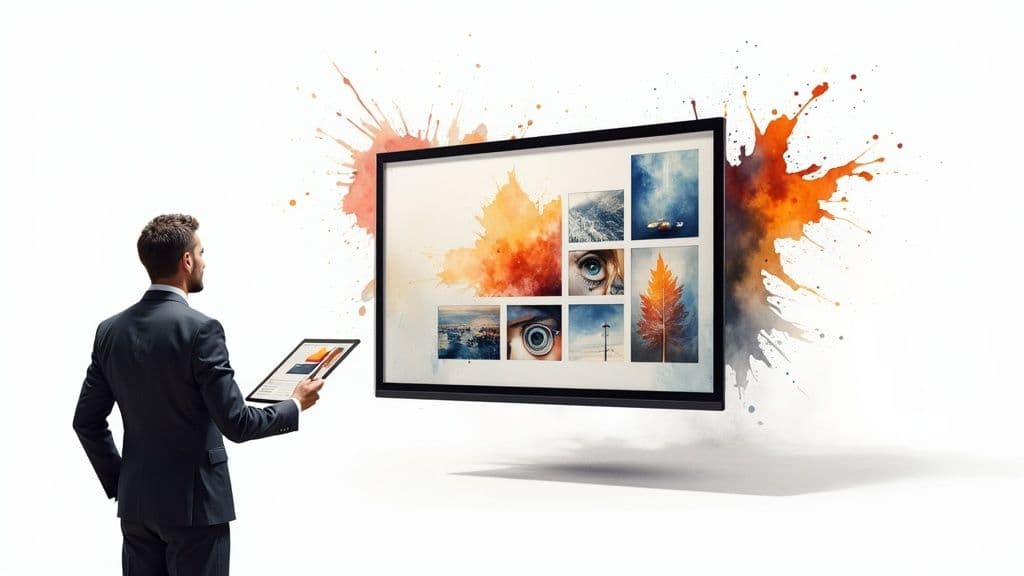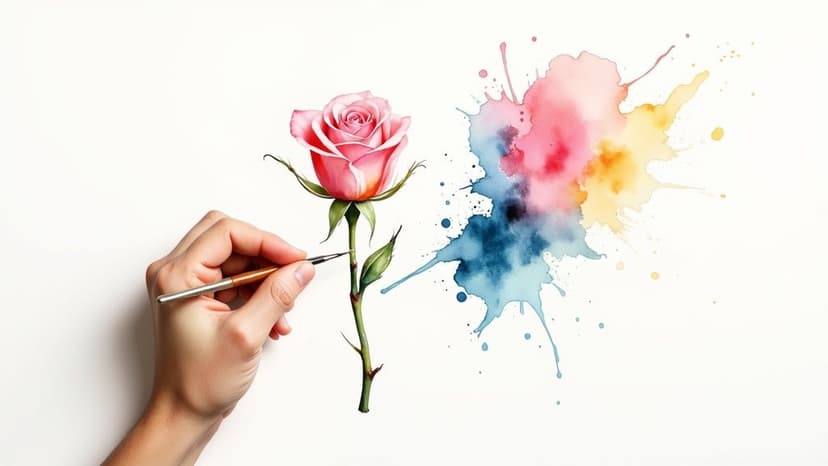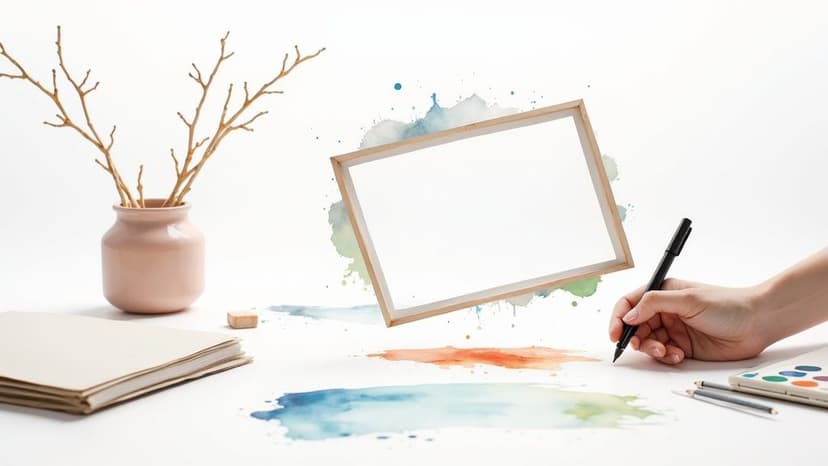
Create Stunning Christmas Trees Vector Graphics
A friendly guide to creating beautiful Christmas trees vector graphics. Learn AI prompts, customization tips, and how to use your festive designs.
Discover how to find and use powerful images for PowerPoint. Our guide covers top sources, design principles, and common mistakes to avoid.

Instastock Team
October 7, 2025 • 13 min read
Let's face it, finding the right images for PowerPoint can be the make-or-break moment for your presentation. Get it right, and you've got a powerful communication tool that inspires your audience. Get it wrong, and you risk putting them to sleep. The best visuals don't just decorate your slides; they grab attention, make tricky concepts crystal clear, and lodge your message firmly in your audience's memory.

We've all been there, haven't we? Stuck in a presentation that drags on, with slide after slide of dense text. The secret to making sure your presentation isn't that one often boils down to your choice of visuals. This isn't just about making things look pretty; it’s a smart, strategic move that taps into a bit of human psychology.
A great image can get a complex idea across in a fraction of a second, completely sidestepping the effort it takes to read and digest a block of text. This is a concept known as reducing cognitive load – basically, you’re freeing up your audience’s mental energy so they can actually focus on what you’re saying. And when information is easier to take in, it’s much, much more likely to be remembered later.
Think of your presentation as a conversation. The words on your slides are the facts and figures, but the images? They provide the emotional context and the compelling story that truly connects you with the people in the room.
In a world where we're all bombarded with information, clear communication is everything. With so many presentations happening every day, you need more than a few bullet points to make an impact. This is where strategic visuals come in.
This is a vital skill for the millions of professionals across the UK who use PowerPoint every single day. A staggering 20.3 million people in the UK have used the software, which tells you just how essential visual communication has become in our working lives. You can dive deeper into the data on PowerPoint's prevalence in the UK to see the full picture.
A presentation without compelling visuals is like telling a story without any descriptive language—it might get the basic facts across, but it will lack the colour and emotion needed to truly connect with the listener.
Ultimately, spending a bit of time finding the perfect images for PowerPoint is an investment in the success of your message. It elevates your slides from a simple backdrop to a dynamic part of your story, ensuring your points aren't just seen, but are actually felt and remembered.

So, you know you need great visuals. That's the easy part. The real question is, where do you actually find them? The internet is overflowing with images, but sifting through them to find the perfect one for your slides can feel like a mammoth task.
Luckily, once you know where to look, finding brilliant images for PowerPoint is much simpler than you think. The best source for you really boils down to your specific needs – your budget, your timeline, and how unique you need the image to be.
With a staggering 35 million presentations given every single day across the globe, the appetite for fresh, engaging imagery is absolutely huge. Seasoned presenters will tell you that the most effective slides keep text to a minimum, around 10–25%, leaving the rest of the canvas for powerful visuals and clean, open space.
For a huge number of projects, free stock photo sites are a fantastic place to start. These platforms have massive collections of professional-looking images you can use without spending a penny, often even for commercial projects. It’s always a good idea to quickly check the licence on each photo, just to be safe.
You'll find many excellent free stock photo sites out there, brimming with high-resolution pictures perfect for general topics like business, technology, or nature.
The only real downside? Because they’re free and popular, you might see the same images pop up in other people's presentations. But if you’re willing to dig a little and get clever with your search terms, you can still unearth some real gems that hit the mark perfectly.
When your presentation absolutely has to shine, it’s worth looking at premium stock sites. Think of these as the curated, high-end galleries of the image world. They offer exclusive, artistic, and often more niche photos that you simply won't find on the free sites.
These services usually work on a subscription basis or let you pay per image. Yes, it comes with a price tag, but you're paying for quality, originality, and the peace of mind that comes with a solid commercial licence. It’s a sure-fire way to make your presentation look polished and professional.
Think of it like this: free sources are like a public library—full of great resources but shared by everyone. Premium sources are like a specialist bookshop, offering curated, unique content for a more discerning audience.
If you want something truly original, the most exciting option today is to create your own visuals with AI. Tools like Instastock let you generate completely unique, high-quality images from a simple text prompt. This is a game-changer because it solves the originality problem once and for all.
Instead of hunting for an image that’s close enough, you can create one that’s an exact match for your content. Imagine needing a picture of "a team of three collaborating around a holographic interface in a sunlit, futuristic office." With AI, you can generate that specific scene in seconds.
This approach also gives you full ownership, so you never have to worry about complex licensing rules again. If you're curious to see what's possible, a great way to start is by exploring some pre-made collections of free images for presentations to get a feel for the incredible quality AI can deliver.
To make the choice clearer, let's break down how these different sources stack up against each other.
Here's a quick breakdown of the pros, cons, and best use cases for each type of image source, which should help you decide which route is right for your next project.
| Source Type | Best For | Pros | Cons |
|---|---|---|---|
| Free Stock Photos | Quick, everyday presentations, blogs, and internal meetings. | Completely free to use. Massive variety for general topics. | Can look generic. The best photos are often overused. |
| Premium Stock Photos | High-stakes client pitches, marketing materials, and keynote speeches. | Exclusive, high-quality, and artistic images. Proper licensing included. | Can be expensive (subscription or per-image cost). |
| AI Image Generation | When you need a highly specific or unique visual that doesn't exist. | Total creative control. 100% original and custom-made. No licensing issues. | Can take time to perfect your text prompts. |
Ultimately, the best approach might even be a mix of all three. You could use free photos for standard slides, a premium shot for your title slide, and an AI-generated image to illustrate a very specific, hard-to-find concept.

Anyone can find an image. The real skill—the one that lifts a presentation from good to great—is finding the right one. A perfect visual does so much more than just fill a blank space on a slide; it clarifies your message, grabs your audience's attention, and helps your key points land.
It’s tempting to just grab the first decent photo you stumble across. But taking a moment to be more deliberate can make all the difference. Instead of settling for "good enough," we need a simple framework to guide our choices.
And don't worry, you don't need a degree in graphic design for this. It’s all about building your visual intuition by asking three simple questions before you ever click 'insert'.
Think of these as your personal quality checklist for every image you consider. If a visual can tick all three of these boxes, you can be pretty confident it’s going to work hard for you.
Choosing an image is like casting an actor for a film. They need to fit the role (relevance), look like they belong in the same world as the other characters (consistency), and deliver a performance that makes the audience feel something (impact).
Once you get into the habit of running your choices through this filter, you’ll naturally start to steer clear of those bland, generic stock photos. You'll begin selecting images for PowerPoint that actively help you communicate more clearly.
Let’s put this into practice. Imagine your slide is titled "Streamlining Team Workflow."
Before: The easy choice is a stock photo of smiling people in a meeting room. It’s not wrong, but it’s vague, overused, and doesn't actually show a streamlined workflow. It's just a picture of people.
After: A much better choice would be a photo of a Kanban board, with tasks flowing smoothly from the ‘To Do’ column to ‘Done’. Or maybe a clean graphic illustrating a simple, circular process. These visuals are instantly recognisable and directly reinforce your core message.
That small mental shift makes a world of difference. You’re no longer just decorating your slides—you're using visuals as a powerful communication tool, making sure every single element on the screen has a job to do.

You’ve tracked down the perfect image. What’s next? The final step is all about weaving it into your slide so it looks like it truly belongs there, rather than being awkwardly dropped in. This is where a few simple techniques inside PowerPoint can make all the difference.
Getting your images for PowerPoint to look their best is part technical skill, part design intuition. From keeping your file size from ballooning to making sure your text is always easy to read, these tips will give your presentation a much more professional finish.
One of the first things you'll run into is file size. High-resolution photos look fantastic, but they can quickly make your presentation file huge and a pain to email or share. The trick is to compress them without sacrificing quality.
You might be surprised by how much control you have right inside PowerPoint, without ever needing to open a separate photo editor. Getting a handle on these built-in tools is the key to a smooth workflow and a polished look.
A massive presentation file is a genuine headache. To keep things manageable, always use PowerPoint's own compression feature. You can dive deeper into the specifics in our guide on how to reduce the file size of photos without making them look blurry.
Beyond compression, it pays to get familiar with these other core tools:
The goal here isn’t to become a photo editing wizard. It’s about knowing which one or two clicks in PowerPoint will make your image look like it was custom-made for your slide.
Once the technical side is sorted, the final touches are all about design and making sure everyone can understand your message. How do you place text over an image without it turning into a jumbled mess?
A go-to trick is to place a semi-transparent shape behind your text. For instance, a dark rectangle with 50% transparency instantly creates enough contrast to make your words leap off the screen.
And finally, never, ever skip the alt text. This is a short, written description of an image that screen readers use to explain visuals to audience members with visual impairments. It's a simple step that makes your work more accessible and inclusive. Just right-click an image, choose 'Edit Alt Text,' and write a brief description. It’s a small effort that shows real professionalism and respect for everyone in your audience.
Imagine having a personal art director on call, someone who just gets the vision in your head. That’s what it feels like to use AI for sourcing images for PowerPoint these days. We've moved way beyond basic keyword searches into a process that feels far more intuitive and, honestly, a lot more creative.
Think about the old way. You’d go to a stock photo site and type in "business meeting." What you’d get back were pages and pages of the same staged, generic photos. It was like sifting through a library’s card catalogue – functional, but slow and rarely inspiring.
AI is different. It’s like talking to an expert librarian who not only hears your words but understands your intent. You can throw abstract concepts at it, like "a feeling of calm innovation" or a "visual that shows collaborative energy," and it understands the mood you're after. This deeper understanding is a massive time-saver.
The real magic of using AI is getting to the right image quickly without compromising on quality. You're no longer scrolling endlessly through near-identical photos. Instead, you can find a unique, genuinely fitting visual in a fraction of the time, which lets you focus on what really matters: your message.
A few features in modern AI tools are incredibly handy for building presentations:
When you're creating images from scratch, the words you use make all the difference. Learning a few prompt keywords to create more realistic AI images can really help you get better results.
The biggest shift with AI is moving from searching for an image that fits your idea to creating an image that is your idea. It’s a move from compromise to creation.
Being able to generate something completely bespoke is a true game-changer. If you want to get into the nitty-gritty, our guide on how to generate images with AI walks you through the entire process.
Ultimately, bringing AI into your workflow means better, more relevant visuals for your slides, and you get them faster than ever before.
Knowing what not to do with your images is just as crucial as knowing what to do. A few common visual slip-ups can easily torpedo an otherwise great presentation, making your hard work look amateurish. The good news? These mistakes are dead simple to spot and even easier to fix once you know what to look for.
Probably the most common offence is the dreaded stretched or squashed image. This usually happens when you resize a photo by grabbing the handles on the side instead of the corners, completely wrecking its proportions. Always, always resize by dragging a corner point to keep everything looking as it should.
Then there's the reliance on cheesy, overused stock photos. You know the ones I mean – the generic shot of business people in a boardroom, all giving a synchronised thumbs-up. These images scream "fake" and can make your message feel bland and impersonal. The solution is to hunt for visuals that feel genuine and tell a more specific, relatable story.
Visual clutter is another big one that can sabotage a slide's impact. It's tempting to cram multiple images onto a single slide to back up your point, but more often than not, this just creates a chaotic mess that confuses your audience.
The golden rule here is clarity over quantity. A single, powerful image will almost always have more impact than three or four fighting for attention. Stick to one core visual per idea.
Finally, keep a close eye on text legibility. Popping light-coloured text over a light background, or dark text over a busy, dark photo, is a surefire way to make your words unreadable. Your audience shouldn't have to squint to understand your point.
Here’s a quick-fix checklist for these common problems:
Still have a few nagging questions about getting images just right for your PowerPoint slides? Don't worry, you're in good company. Let's walk through some of the common hurdles people face, so you can build your presentations with total confidence.
Nailing these details is all about working smarter, not harder, and making sure your final presentation looks as polished as possible.
For any standard 16:9 widescreen slide, your go-to resolution should be at least 1920 pixels wide by 1080 pixels tall. Think of this as your "full HD" baseline. It ensures your pictures look sharp and professional on most modern screens, from laptops to big projectors, without any of that dreaded fuzziness.
A good rule of thumb is to always start with a larger, higher-quality image and let PowerPoint scale it down. If you grab a small picture and try to stretch it to fit, it'll just end up looking pixelated and unprofessional, which can seriously distract from your message.
The safest and most straightforward way is to get your images from reputable stock photo websites that offer clear licences. Sites like Unsplash or Pexels often provide a Creative Commons (CC0) licence, meaning you can use the images for free. For more specific needs, paid sites like Getty Images or Adobe Stock offer licences for commercial use.
Never just grab an image from a Google search and assume it's okay to use. The vast majority of images online are copyrighted. Using them without permission, especially in a business or corporate presentation, can land you in some very hot water.
This is a classic design challenge, but there are some simple, elegant solutions. One of my favourite tricks is to place a semi-transparent shape right behind the text. A simple black or dark grey rectangle set to about 50-60% transparency can work wonders. It creates a subtle background that helps your text stand out without completely hiding the image behind it.
Another great method is to find a "quiet" spot in the photo itself. Look for areas with less detail, like a clear blue sky, a calm patch of water, or a plain wall. Placing your text there creates natural contrast and keeps everything looking clean and easy to read. You can also apply a subtle blur to the part of the image directly beneath your words.
Ready to stop searching and start creating? With Instastock, you can generate the exact custom visual you need in seconds, and it’s all yours. Start creating your first five images for free.

A friendly guide to creating beautiful Christmas trees vector graphics. Learn AI prompts, customization tips, and how to use your festive designs.

Learn how to create a stunning AI drawing of a flower. Our friendly guide covers everything from prompts and styles to editing your digital floral art.

Discover how to create stunning AI photo frames templates. This guide offers actionable tips for designers and marketers to elevate their visual content.